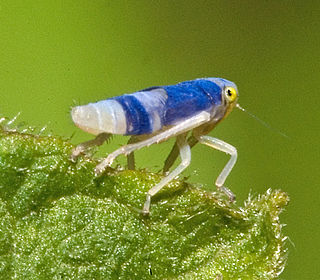
The Pentatomoidea are a superfamily of insects in the suborder Heteroptera of the order Hemiptera. As hemipterans, they possess a common arrangement of sucking mouthparts. The roughly 7000 species under Pentatomoidea are divided into 21 families. Among these are the stink bugs and shield bugs, jewel bugs, giant shield bugs, and burrower bugs.

Leafhopper is the common name for any species from the family Cicadellidae. These minute insects, colloquially known as hoppers, are plant feeders that suck plant sap from grass, shrubs, or trees. Their hind legs are modified for jumping, and are covered with hairs that facilitate the spreading of a secretion over their bodies that acts as a water repellent and carrier of pheromones. They undergo a partial metamorphosis, and have various host associations, varying from very generalized to very specific. Some species have a cosmopolitan distribution, or occur throughout the temperate and tropical regions. Some are pests or vectors of plant viruses and phytoplasmas. The family is distributed all over the world, and constitutes the second-largest hemipteran family, with at least 20,000 described species.

Treehoppers and thorn bugs are members of the family Membracidae, a group of insects related to the cicadas and the leafhoppers. About 3,200 species of treehoppers in over 400 genera are known. They are found on all continents except Antarctica; only five species are known from Europe. Individual treehoppers usually live for only a few months.

The superfamily Membracoidea of sap-sucking true-bugs includes two of the largest families within what used to be called the "Homoptera": the leafhoppers (Cicadellidae) and the treehoppers (Membracidae). The other families in this group are quite small, and have, at various points, generally been included as members within other families, though they are all presently considered to be valid, monophyletic groups. The relict family Myerslopiidae is restricted to New Zealand and South America while the Melizoderidae consist of two genera restricted to South America. The great diversity of Neotropical taxa suggests that the group originated in that region.

Eurybrachidae is a small family of planthoppers with species occurring in parts of Asia, Australia and Africa. They are remarkable for the sophistication of their automimicry.

The Bosawás Biosphere Reserve is a tropical rainforest in Nicaragua designated as a UNESCO biosphere reserve in 1997. At approximately 20,000 km2 in size, the reserve comprises about 15% of the nation's total land area. It is the second largest rainforest in the Western Hemisphere, after the Amazon Rainforest in Brazil. Bosawás is largely unexplored, and is extremely rich in biodiversity.

Jerusalem crickets are a group of large, flightless insects in the genera Ammopelmatus and Stenopelmatus, together comprising the tribe Stenopelmatini. The former genus is native to the western United States and parts of Mexico, while the latter genus is from Central America.

Gaga is a genus of 19 species of ferns in the family Pteridaceae named after American singer and songwriter Lady Gaga. Two of the 19 species are newly-described: Gaga germanotta from Costa Rica, named after the family of the singer, and Gaga monstraparva, in honor of Gaga's fans, whom she calls "little monsters". According to biologists, the ferns bear a close resemblance to Gaga's costume from the 52nd Annual Grammy Awards and also bear a distinct DNA sequence spelling GAGA.

Typhlocybinae is a subfamily of insects in the leafhopper family, Cicadellidae. This is currently the second largest leafhopper subfamily based on the number of described species, but researchers believe there are so many taxa yet undescribed that it is probably the largest subfamily. Approximately 6000 species have been described thus far.

Dinidoridae is a small family of hemipteran "true bugs" comprising about sixteen genera and a hundred species the Hemiptera suborder Heteroptera. As a group the family does not have any common name. Until the late 19th century they were generally regarded as a subfamily of Pentatomidae.
Aleiodes gaga is a species of parasitoid wasp belonging to the family Braconidae. It was first described by Donald Quicke and Buntika Butcher in 2012 after a single individual was discovered in the Chae Son National Park in Thailand. The species is named after Lady Gaga. This species is one of 179 species identified by the first "turbo-taxonomic" search of DNA barcoding of cytochrome oxidase I (COI).

Aetalionidae are a family of treehoppers in the superfamily Membracoidea. Aetalionidae are somewhat like Membracidae in that they have one to three rows of short spines on the hind tibia but differ in having the front femur fused to the trochanter and the scutellum is completely exposed. The females have finger-like protrusions on the genital capsule. The family is mostly Neotropical. The subfamily Biturritiinae is Neotropical while the subfamily Aetalioninae has a Neotropical genus Aetalion and the sole Old World representative genus Darthula with a single species Darthula hardwickii.

Hecalini is a tribe of leafhoppers in the family Cicadellidae. There are about 24 genera and over 180 described species divided into two subtribes in Hecalini.

Phlepsiini is a tribe of leafhoppers in the subfamily Deltocephalinae. There are 4 genera and over 80 described species in Phlepsiini.

Scaphoideini is a tribe of leafhoppers. There are 64 genera and over 600 described species in Scaphoideini.

Bocydium is a genus of insects in the treehopper family, Membracidae. A 1999 classification identified 14 species in the genus, distributed around the Neotropics.
Laura Sullivan-Beckers is an associate professor of evolutionary biology at Murray State University. She is credited with the discovery of Hebetica sylviae, a species of treehopper, named for her daughter Sylvie Beckers.

Chandrashekaraswami Adiveyya Viraktamath is an Indian entomologist who specializes in the systematics of leaf-hoppers, Cicadellidae. He served as a professor of entomology at the University of Agricultural Sciences, Bangalore.

Hebetica sylviae is a member of the treehopper family Membracidae. It is found in the eastern United States, first discovered in Murray, Kentucky, with a second sighting in Atlanta, Georgia.

















